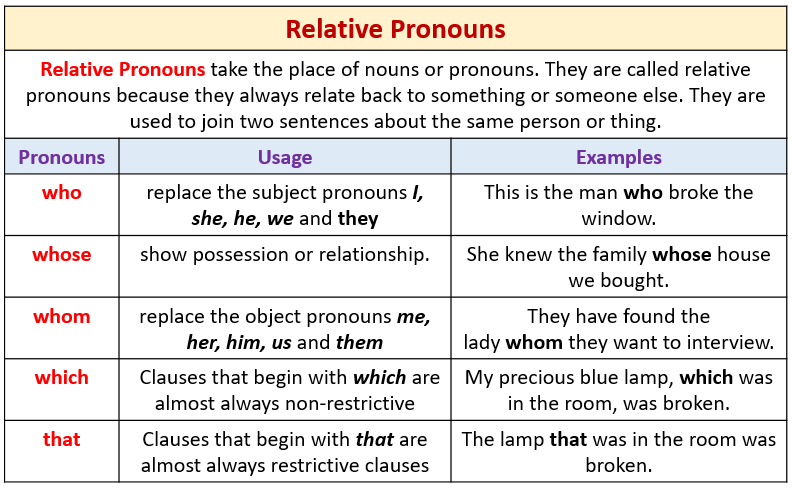Relative Pronouns
Related Pages
Types of Pronouns
Personal Pronouns
Possessive Pronouns
Subject Pronouns, Object Pronouns, Reflexive Pronouns
More Lessons On English Grammar
In these lessons, we will learn when to use each of the relative pronouns:
"who", "whom", "which" and "that".
A pronoun is a word that takes the place of a common noun or a proper noun.
Relative Pronouns take the place of nouns or pronouns. They are called relative pronouns because they always relate back to something or someone else. They are used to join two sentences about the same person or thing.
The following diagram shows some relative pronouns and examples of how they are used. Scroll down the page for more examples of relative pronouns.

The main relative pronouns are: who, whose, whom, which, and that. We use who, whose and whom to make statements about people; which to refer to things; that to refer to either people or things.
Examples:
This is the man who broke the window.
(who refers back to man)
I have a friend whose mother drives a taxi. (whose refers back to friend)
Here is the car which she bought for her son. (which refers back to the car)
It is the kind of dress that I like. (that refers back to the dress)
She is a person that can be trusted. (that refers back to person)
Other forms of relative pronouns include whoever, whomever, whatever, and whichever.
When To Use "Who" And "Whom"
We use who to replace the subject pronouns I, she, he, we and they.
Examples:
This is the man who broke the window.
(He broke the window - who replaces he)
Where is the waiter who served us? (She served us - who replaces she)
We use whom to replace the object pronouns me, her, him, us and them. However, the use of whom is becoming less common, especially in the United States, and who is usually used instead of whom.
Examples:
The lady whom they caught was sent to prison. (They caught
her – whom replaces her)
They have found the man whom they want to interview. (They want to interview him – whom replaces him)
When To Use "Whose"
We use whose to show possession or relationship.
Examples:
I have a friend whose mother drives a taxi.
She knew the family whose house we bought.
Relative Pronouns With Restrictive And Nonrestrictive Clauses
A clause is a group of words that consists of a subject and a predicate. A restrictive clause is used when the information in the clause is important to the meaning of the overall sentence. A nonrestrictive clause is used to indicate that the information in the clause is extra information.
Examples:
The woman who is standing at the door is his sister.
Jane, who is standing at the door, is his sister.
In the first sentence, the clause who is standing at the door is important because it identifies the woman.
In the second sentence, the clause who is standing at door is extra information. In order to indicate that it is nonrestrictive we use commas before and after the clause.
When To Use "That" And "Which"
Clauses that begin with that are almost always restrictive clauses, and therefore do not need commas. Clauses that begin with which are almost always nonrestrictive, and therefore do need commas.
Examples:
The lamp that was in the room was broken.
(The clause that was in the room identifies the lamp.)
My precious blue lamp, which was in the room, was broken. (The clause which was in the room gives extra information.)
Relative Pronouns and Interrogative Pronouns
Relative Pronouns Song
Relative Pronouns
Pronoun Case (Subjective, Objective, Possessive),
Using Relative Pronouns (Comparisons, Modifiers, We vs. Us, Who vs. Whom)
Try the free Mathway calculator and
problem solver below to practice various math topics. Try the given examples, or type in your own
problem and check your answer with the step-by-step explanations.

We welcome your feedback, comments and questions about this site or page. Please submit your feedback or enquiries via our Feedback page.